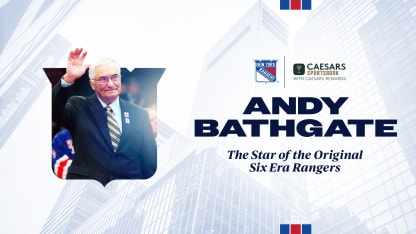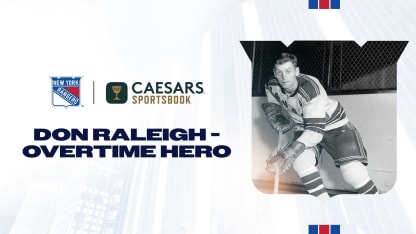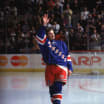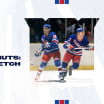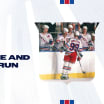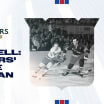On November 29, 1962, Andy Bathgate scored a goal, recorded an assist on two other goals, and helped the Rangers defeat the Detroit Red Wings, 5-0.
Scoring goals and tallying points was nothing new for Bathgate; the season prior, his 84 points were tied with Chicago’s Bobby Hull for the most in the NHL. But on this particular night, Bathgate’s goal had a special significance. The goal was the 229th of Bathgate’s remarkable career, and he passed Bill Cook – one of the original Rangers and the team’s first captain – to become the franchise’s all-time leader in goals.
Following his goal that night in Detroit, Bathgate became the holder of the Blueshirts’ franchise records in every major offensive category – most career goals, most career assists, and most career points, as well as most goals in one season, most assists in one season, and most points in one season (in addition to these records, he also began a franchise-record 10-game goal streak a few weeks later; the 10-game goal streak still remains a Rangers record today).
It is fitting that Bathgate held all of these records at one point in time, for he was unquestionably the Rangers’ star for the majority of his tenure in New York.
“He was big, strong, and almost statuesque,” said MSG Network play-by-play broadcaster Sam Rosen, who idolized Bathgate as a kid growing up in New York and watching the Rangers. “He was an excellent skater, had a great shot, and was a great scorer. He was the guy. He was the Rangers’ star player and the leader of the pack.”
Bathgate was born in Winnipeg in 1932. The Rangers had a long connection with Winnipeg, as the team held its Training Camp there from 1934 through 1946, and the city became a pipeline of sorts for the Rangers to sign young, talented players. This would be the case with Bathgate as well, as the Rangers first signed his brother, Frank (who was two years older than Andy), before signing him.
After playing minor hockey in Winnipeg, Bathgate joined the Guelph Biltmore Mad Hatters (known as the Biltmores) in 1949-50, where he became part of a group of players that would become known as the “Guelph Gang”. Shortly after Frank Boucher became the Rangers’ General Manager in 1946, he focused on rebuilding the Rangers’ farm system with several sponsored junior teams throughout Canada, and one of those teams was in Guelph.
The Biltmores, who were coached by former Ranger Alf Pike, achieved considerable success during Bathgate’s three full seasons with the team. Guelph won the league championship in both 1949-50 and 1951-52, and in 1951-52, the team also won the Memorial Cup. That team was led by the “Guelph Gang”, which featured eight players who would go on to play with the Rangers in the NHL – Bathgate, Harry Howell, Dean Prentice, Ron Murphy, Lou Fontinato, Ron Stewart, Aldo Guidolin, and Bill McCreary.
Bathgate’s NHL career with the Rangers began in 1952-53, but it was almost derailed as a result of a knee problem he had during the Memorial Cup run with Guelph the season prior. As longtime Rangers’ public relations director and historian John Halligan described the situation years ago, “doctors in Guelph diagnosed torn cartilage in (Bathgate’s left) knee and recommended surgery. Frank Boucher wasn’t so sure, and Bathgate was brought to New York and put in the care of Dr. Kazuo Yanagisawa, the Rangers’ legendary orthopedic surgeon. Yanagisawa detected a ‘loose kneecap,’ requiring a different kind of surgery and the insertion of a steel plate in Bathgate’s knee.”
Bathgate played part of the 1952-53 and 1953-54 seasons with the Rangers, but by 1954-55, he was a mainstay in the team’s lineup. With each passing season, his star became brighter, his scoring totals increased, and the Rangers became a better team as a result. Prior to Bathgate’s arrival, the record for most points in a season by a Ranger was 62 (Boucher tallied 62 points in 1929-30) and the record for most assists in a season by a Ranger was 42 (Don Raleigh notched 42 assists in 1951-52).
Bathgate eclipsed both of those marks by registering 66 points and 47 assists in 1955-56 while helping the Rangers reach the playoffs for the first time in six seasons. The following season, he eclipsed both of his own records with 77 points and 50 assists, finished third in voting for the Hart Trophy as the NHL’s Most Valuable Player behind Detroit’s Gordie Howe and Montreal’s Jean Beliveau, and once again led the Rangers to a playoff berth. In 1957-58, Bathgate tallied 30 goals for the first time in his NHL career, set a single-season franchise record (again) for points with 78, and helped the Rangers make the playoffs for the third consecutive season. In addition, he was the runner-up to Howe for the Hart Trophy and was named to the NHL’s Second All-Star Team at right wing.
The Original Six Era was the golden age for players wearing No. 9. Besides Bathgate in New York, Howe wore the number in Detroit, Maurice Richard wore the number in Montreal, Johnny Bucyk wore the number in Boston, Ted Kennedy wore the number in Toronto, and Bobby Hull wore the number in Chicago. All six players are in the Hockey Hall of Fame, and all six players had that number retired by their respective franchises.
For the years he played with the Rangers, Bathgate was as valuable to the success of his team as much as Howe was to the Red Wings or Richard was to the Canadiens. Throughout his tenure, Bathgate was unfortunately overshadowed by his fellow right wings. Except, however, in 1958-59, when Bathgate won the Hart Trophy, became the first Ranger to score 40 goals in a season, and tallied a career-high 88 points. His prowess and popularity were also recognized when, during that 1958-59 season, he became the first Ranger to be featured on the cover of Sports Illustrated.
Bathgate was named the Rangers’ captain prior to the start of the 1961-62 season, his 10th campaign with the team, and he had one of the best seasons of his career. Besides leading the NHL with 56 assists (establishing another single-season Rangers record in the process), tying Hull for the NHL lead with 84 points, and being named to the NHL’s First All-Star Team, Bathgate had arguably the defining moment of his career, upstaging Howe and one of his greatest career achievements in the process.
On March 14, 1962, the Rangers hosted the Red Wings at MSG. Entering the game, the two teams were tied for the last playoff spot; the Rangers had five games remaining in the season and the Red Wings had six games remaining. A Rangers win in that contest was going to give the team a significant boost in their quest to claim a playoff berth.
Bathgate opened the scoring in the first period to give the Rangers a 1-0 lead. The Red Wings tied the game late in the first period, and in the second period, Howe scored his 500th career NHL goal – joining Richard as the only players in league history to reach that feat – to give Detroit the lead.
The Rangers fans at MSG gave Howe a standing ovation, recognizing his milestone goal, but also recognized that the goal could be damaging to the team’s playoff hopes. Fortunately for ‘The Garden Faithful’, Earl Ingarfield tallied a power play goal less than a minute after Howe’s goal to tie the game.
Then, midway through the third period, Bathgate’s longtime linemate, Dean Prentice, had a chance to give the Rangers the lead on a breakaway. Detroit’s goaltender Hank Bassen threw his stick in attempting to stop Prentice, which resulted in referee Eddie Powers awarding a penalty shot to the Rangers. But instead of awarding the shot to Prentice, Powers said that Bathgate would take the penalty shot.
Despite Detroit’s arguments, Bathgate skated to center ice to take the penalty shot. With potentially the game – and as a result the fate of the season – on his stick, Bathgate skated towards the net, faked a shot on his forehand to get Bassen moving to one side, and then skated around him and slipped the puck on his backhand into the yawning net.
As hockey historian Stan Fischler described it, “Bathgate’s fake on Bassen was so good that if there weren’t boards around the rink, Bassen would have ended up in the Hudson River. It was the absolute perfect, dramatic move.”
The Rangers won the game and ultimately finished four points ahead of the Red Wings to make the playoffs.
Bathgate’s tenure with the Rangers ended in February of 1964 when – as the team looked towards the future and began to replenish their farm system with young players – he was traded to the Maple Leafs. With Toronto, Bathgate helped the team win the Stanley Cup, and he scored what proved to be the game-winning goal for the Maple Leafs in Game 7 of the 1964 Stanley Cup Final over the Red Wings.
During the 25 seasons of the Original Six Era (1942-43 – 1966-67), only Howe, Richard, and Beliveau tallied more points than Bathgate’s 870, and only Howe had more assists than Bathgate’s 556. Bathgate led the Rangers in points for eight consecutive seasons (1955-56 – 1962-63), a feat which no player in franchise history has since matched. He was selected as the Rangers’ Most Valuable Player for three consecutive seasons (1956-57 – 1958-59), and it wasn’t until Henrik Lundqvist in the late 2000s that any Ranger received the award in three or more straight seasons.
Rod Gilbert ultimately broke Bathgate’s career franchise records during his tenure with the Blueshirts. But, as “Mr. Ranger” said, Bathgate was an inspiration and mentor for him, both when Gilbert was growing up and when he and Bathgate were teammates in New York.
“Andy Bathgate was my hero,” Gilbert said as part of the NHL’s 100 Greatest Players series in 2017. “I got (to New York), and he was my mentor. And I wanted to emulate everything he did.”
Bathgate’s No. 9 jersey was retired alongside Howell’s No. 3 jersey in a pre-game ceremony on February 22, 2009. It was a well-deserved honor for a player who was the face of the franchise during the Original Six Era and one of the best to wear the Rangers uniform.

